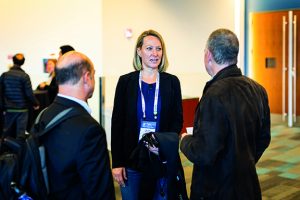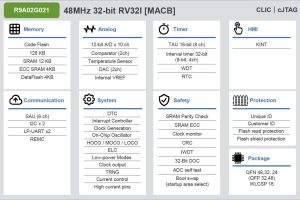
Risc-V International promotes adoption of the open standard instruction set and an ecosystem of hardware and software.
Calista says the momentum is international, with a strong balance of Risc-V development and momentum across the US, Europe, Asia and other regions. In the US, she notes, momentum is growing across industries.
At the Digital Automation Conference earlier this year she moderated a Risc-V panel that included executives from Imperas, Intel Foundry Services, Meta, OpenHW Group and Ventana discussing their Risc-V activities. “One thing that stood out was Himanshu Sanghavi, asic engineering manager at Meta, discussing how Meta is using Risc-V to run extremely compute intensive applications in data centres, including video transcoding and machine-learning applications,” she recalls.
Bob Brennan, vice-president, GM, at Intel Foundry Services, has announced that the company has “40 plus people working in various working bodies across Risc-V International”.
“Europe is continuing to ramp up Risc-V investment beyond the research and academic community,” says Calista. At the first annual Risc-V Summit Europe Luis-Carlos Busquets-Perez, administrator at the EU Commission, said that open standards such as Risc-V have “a very important economic impact in the European economy,” she continues, adding that the European Space Agency’s Roland Weigand called Risc-V a “rising star in space.”
There is also activity in Asia, not only in volumes, but in growth and activity moving Risc-V from embedded to enterprise. There is also innovation in India, says Calista, citing the launch of the Digital India Risc-V (DIR-V) programme by the Ministry of Electronics and Information Technology (MeitY) to develop local microprocessors.
There are now three Risc-V summits, in Europe, North America and China, and the RisC-V ecosystem is expanding and strengthening in growth markets such as India, Japan and Latin America, reports Calista. “A couple of years ago, nearly a quarter of design starts included Risc-V. More recently, analysts have said that it has become difficult to find a design start that does not include Risc-V. In total, there are more than 10 billion Risc-V cores in the market today,” she says.
Risc-V growth
Areas of growth in Risc-V adoption this year and next are data centres, automotive and mobile, particularly around 5G. In the data centre market, Risc-V is used for acceleration and AI, as well as building toward higher performance central processing. One example is Meta’s MTIA v1 AI inference accelerator with two Risc-V processor cores (one with vector) customised for compute and control, says Calista.
In automotive, there have been announcements from Mobileye on ADAS chips capable of 176 trillion ops per second with 12 Risc-V CPU cores.
Last December Qualcomm confirmed it had shipped 650 million Risc-V Cores, while Taiwan’s Andes Technology has introduced Risc-V into the Bluetooth and Wi-Fi processing within handsets.
“Risc-V is levelling the playing field for companies big and small to become successful in the microprocessor space. This has opened up hundreds of new companies and invested large companies to possibilities they could not pursue on any other architecture,” she adds.
Career path
Calista grew up in rural Minnesota, US. A common thread through her studies was how technology could be a means to achieving positive change in the world.
“While doing my MBA, I also did deep studies on sustainability, which included learning about the financial, social and environmental impact of business decisions. The study of corporate responsibility is much deeper than marketing employee volunteering or other outreach. At its core, corporate responsibility is about pushing for strategic directions and investment that furthers the company financial goals, while reducing environmental impact and supporting social goals through employee and community best practices,” she says.
She began a long career at IBM, following an internship with the company. “IBM is well known for its support of women in technology and that was important to me. It is known for having very clear guidelines on where it will apply its technical expertise and where it will not. Having those guidelines was foundational to my own thinking in how I lead organisations and initiatives,” she says.
There, she initially worked on acquisitions, divestitures and alliances. “Honing my strategic and business skills was instrumental for my career because I was able to apply strategic thinking and management into building mutually successful relationships, which are the core to any ecosystem.”
Being heard in the workplace can be difficult, she says, and “especially challenging early in a career as assumptions proliferate regarding level of experience or domain expertise to offer a meaningful perspective. Although a lot of people face this obstacle, it is often more difficult for young women early in their career. Unfortunately, many women continue to face deeply held bias in very male-dominated technical fields.”
Her advice is to not only become an expert in your field, but also find ways to communicate that get your point across. “Sometimes it’s a video, a blog, a one-on-one conversation, or in front of a microphone. Learning how to effectively communicate in different ways is very important.
“For me, this obstacle was most readily overcome when I had the opportunity to work with people who had also overcome age, experience, or gender bias. I have been fortunate to have role models who respected and heard viewpoints that were different from their own, across spectrums of diversity. I have shaped my own leadership style to value the perspectives of everyone – regardless of role – even when I may not agree with them.”

Calista feels fortunate to have worked in meritocracies, both at IBM and in open communities. One of the main challenges she sees is the low percentage of women working in the hardware side of the industry.
“It is getting marginally better as we have had more women step into leadership roles. We strive to improve diversity in the workplace by cultivating female leadership/role models within teams and providing eminence to individuals through awards and promotions,” she says.
“Work-life balance is always tough and especially complicated when you add families to the picture. It is important to always understand and appreciate that everyone has families and pressures that need their attention. Alleviating and supporting employees in their whole lives helps to build a positive and supportive culture where employees can grow their careers,” she adds.
She recalls some discrimination based on being a woman. “There have been many instances where… others felt the need to explain my own ideas to me, or to repeat them to others. I have had things that I am a deep expert in explained back to me. During these situations, I try to approach the issue with the same respect that I’m asking for.
“It’s important to address discrimination directly to create a more inclusive work environment. I am also not shy to point out that someone is repeating the same idea I’ve just shared. I’m polite and direct, while maintaining mutual respect.
Change in the industry
Calista believes that change for diversity and inclusion begins at university. This is where undergraduates decide on their career path and where they form decisions based on the companies they admire and the faces they see as peers, instructors, campus recruitment and perhaps at trade shows. “It’s important for people to see themselves reflected at a company,” she says. “Companies that really invest in diversity should be engaging with many different groups, such as female engineering groups, cultural groups, early career support, and more to build peer networks throughout career stages,” she adds.
In the workplace, having different perspectives at the table is important when building relationships, creating alliances and furthering the efforts of a community. Gender and communication style is very important here. Engaging with all different types of people is critical in the workplace and beyond.
“It’s important that women serve as visible role models,” says Calista. “We should be cultivating women as leaders at all levels and giving them visibility. For example, bringing women who are junior level staff to recruiting events or encouraging early career folks to become ambassadors in open communities can help attract and retain other women. We have an ambassador community at Risc-V, which gives a lot of visibility to mid-level career folks.”
Risc-V’s own mentoring programme is aimed at cultivating talent in technical and non-technical arenas. “I spend time with our mentees, who participate in formal multi-week mentorship programmes. We also offer DEI scholarships to Risc-V events as a key part of our programming.
“There are also a lot of educational resources in the Risc-V ecosystem for people at all levels of their career to brush up on their skills and make themselves more competitive for the job market. In parallel, we offer a job board, career fairs and various types of webinars,” she says.
Students are encouraged to actively engage in Risc-V major events, such as Risc-V summits in China, Europe and North America, to learn from experts and network for job opportunities.
Her advice for young women considering a degree in electronics engineering today is simple: “Go for it!” She points out that there are more job openings than candidates at the moment and the field [of electronics] will continue to grow. “Seek out opportunities from companies that share your values and offer support for growing your career both inside the company and externally within the industry,” she advises.
Calista has two daughters and she has brought them into work whenever possible since they were born. Neither seems interested in a career in technology, she says, but she is excited at their love of maths. “In terms of advice, I do my best to be a good role model for them. I try to show them that I love my job, and that my job is getting to work with brilliant people.
“I also try to show them that I am excited to work somewhere where I have the opportunity to help fundamentally change the course of computing. I try not to offer up advice, I just live my example. They tell me they want a job like mine one day, so it must be working,” she says.
 Electronics Weekly Electronics Design & Components Tech News
Electronics Weekly Electronics Design & Components Tech News



